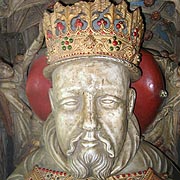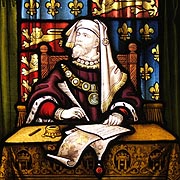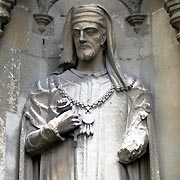
Henry IV (1367-1413) - King of
England 1399-1413
 |
 |

|
 |
King Henry IV, the eldest surviving son of Prince John of Gaunt, Duke of Lancaster, and his wife, Blanche of Lancaster, was born at Bolingbroke Castle in Lincolnshire. He became Earl of Derby in 1377, married Mary Bohun, coheiress of the Earldom of Hereford, in 1380, and became, in 1387, one of the five leaders of the opposition to the Government of his cousin, Richard II. However, in 1389, he rallied to the Crown.
In 1390 and 1392, Henry went, with a considerable following, upon two so-called 'crusades' to the Eastern Baltic, on pretext of aiding the Teutonic Knights against the Lithuanians, who had recently accepted Christianity. Upon the conclusion of the second of these expeditions, he crossed Germany to Venice and thence paid a flying visit to Jerusalem, being thus the only English King before Edward VII to have seen the Holy Sepulchre.
From Henry’s return to England, in 1393, he took, until 1397, little part in politics, but what influence he had was used upon the side of the Crown and against his own friends of ten years before. He was created Duke of Hereford in 1397. In this capacity he had an open quarrel with Thomas, Duke of Norfolk, whom he accused of treasonable designs. The quarrel was to be decided by combat at a joust in the King's presence at Coventry in September 1388. King Richard stopped the combat when the duellists were already in the lists and banished both of them, although professing to Hereford great regret at doing so.
 |
 |

|

|
Henry went to Paris and awaited his opportunity for revenge. This opportunity came at the death of his father, John of Gaunt, in February 1399. For Richard, who had promised the exile that his paternal estates should be secured to him, now confiscated the whole of the Lancastrian inheritance. Henry, whose whole life in England had been devoted, in accordance with the traditions of his house, to a quiet but steady conciliation of popular favour, was no doubt well informed of the growing unpopularity of Richard. He, therefore, took advantage of Richard's absence in Ireland to land in Yorkshire with a few followers, professing to claim only his paternal inheritance of Lancaster. But, as he advanced south-westwards, he was received with such acclamations and joined by such powerful men - notably the Percys of Northumberland - that he was able to take a sharp vengeance on the unpopular ministers of Richard. Many of these, he beheaded before advancing in overwhelming force to meet the King upon his return from Ireland. Richard submitted tamely and Henry issued writs, still in Richard's name, for a parliament in London. At this Parliament, in September 1399, Henry claimed the Crown, which Richard resigned, and was joyfully accepted as King by both Houses. The popularity of the House of Lancaster veiled the essential illegality of the business. A month later Richard was condemned to perpetual imprisonment and was never seen again. A rising of his friends in the following year was easily put down, and it is supposed that this led to Richard's murder at Pontefract.
Henry's reign, however, was never for a moment quiet and treason always dogged the steps of the King who had usurped the throne. His enemies constantly tried to poison or assassinate him. France and Scotland were both hostile. Even Wales was able to lift its head in little spurts of rebellion. Pseudo-Richards began to appear in various parts of England and their appearance was always the signal for revolts. The state of society, which had been unquiet for a quarter of a century, went from bad to worse during Henry's reign. The King was constantly on the move endeavouring to repress sedition and riots, and was generally successful in doing so for the time; but, directly he had passed by, they broke out again behind him. Thus, his own friends, the Percys, revolted, joined the Welsh and raised the flag of the Mortimers in 1403. They were beaten in a pitched battle at Shrewsbury. In 1405, it was the Mowbrays, Scropes and Percys who were up again, and Henry was actually obliged to behead the Archbishop of York. Again, in 1408, a similar rebellion in the North had to be put down. In his last years, 1410-13, the Prince of Wales seems to have given him trouble.
Henry died in March 1413, broken down by ill health and hard work at the age of forty-six. Probably his character changed, to some extent for the better, after his accession. He never lost his popularity with the House of Commons, to which he constantly made valuable concessions of a 'constitutional' nature. Nor, in spite of his execution of an archbishop, with the Church, to which he and his Parliament gave the long-desired privilege of burning heretics alive. Nor with the citizens of London, whom he always ostentatiously courted. From 1404, his health seems to have been uniformly bad. By his first wife, Mary Bohun, he had four sons, Henry V; Thomas, Duke of Clarence; John, Duke of Bedford; and Humphrey, Duke of Gloucester. By his second wife, Joan, the widowed Duchess of Brittany, he had no children.
Edited from CRL Fletcher's 'Historical Portraits' (1909)
The pictures on this page are cropped examples of images in our high resolution photo library. Please e-mail us for details of these or similar image availability at our very reasonable reproduction rates. Location release may be required for some photos.
Click for Next
Monarch